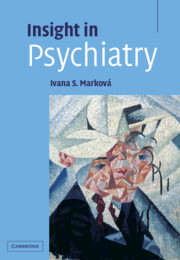Book contents
- Frontmatter
- Contents
- Dedication
- Preface
- Part I Historical and Clinical
- Part II Conceptual
- 6 The conceptualisation of insight
- 7 The relational aspects of insight: the ‘object’ of insight assessment
- 8 Towards a structure of insight: awareness and insight, an essential distinction?
- 9 Towards a structure of insight: the relationship between awareness and insight
- References
- Index
8 - Towards a structure of insight: awareness and insight, an essential distinction?
from Part II - Conceptual
Published online by Cambridge University Press: 22 October 2009
- Frontmatter
- Contents
- Dedication
- Preface
- Part I Historical and Clinical
- Part II Conceptual
- 6 The conceptualisation of insight
- 7 The relational aspects of insight: the ‘object’ of insight assessment
- 8 Towards a structure of insight: awareness and insight, an essential distinction?
- 9 Towards a structure of insight: the relationship between awareness and insight
- References
- Index
Summary
Various conceptual issues arising in the study of insight have now been identified and their likely role explored with respect to providing some explanation for the variable results obtained in empirical work on insight. It is evident that empirical research on insight faces many difficulties most of which relate to the ways insight is treated theoretically and to the sense that is made of the clinical phenomenon elicited. These, in turn, reflect the complexities inherent to the nature of insight as a concept. It remains crucial, however, notwithstanding the difficulties involved, to continue with efforts focused on clarifying and understanding the conceptual problems surrounding the study of insight. The meaningfulness of empirical studies, i.e. their theoretical significance and clinical importance as well as their limitations, is necessarily dependent on the level of such conceptual understanding. While the previous chapters focused on unpacking some of these conceptual problems, these last two chapters aim to bring together the identified points and issues with a view to developing a basic preliminary structure for the concept of insight. This chapter focuses on exploring the distinction between awareness and insight, and determines this as theoretically important and clinically relevant. The next chapter explores the relationship between awareness and insight in the context of a proposed overall structure for insight.
In Chapter 1, and following Berrios (1994a; 1996), it was pointed out that terms, concepts and behaviours do not inevitably correspond in a one-to-one manner to an object of inquiry.
- Type
- Chapter
- Information
- Insight in Psychiatry , pp. 243 - 270Publisher: Cambridge University PressPrint publication year: 2005



